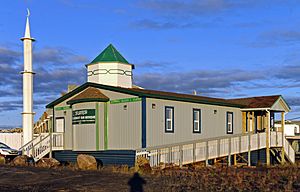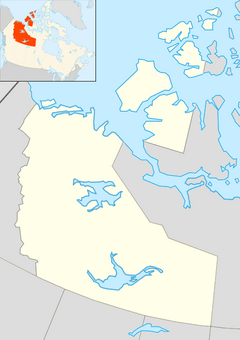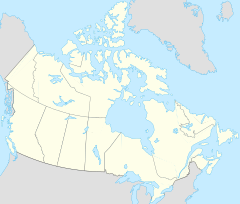Midnight Sun Mosque facts for kids
Quick facts for kids Midnight Sun Mosque |
|
|---|---|

Mosque in the midnight sun, July 2015
|
|
| Religion | |
| Affiliation | Islam |
| Year consecrated | 2010 |
| Location | |
| Location | 29 Wolverine Road, Inuvik, Northwest Territories, Canada |
| Architecture | |
| Architect(s) | Fathallah Farjat (dome and minaret) |
| Architectural style | Islamic original architecture |
| Founder | Zubaidah Tallab Foundation |
| Groundbreaking | 2010 |
| Completed | November 10, 2010 |
| Specifications | |
| Direction of façade | NNE |
| Capacity | ~100 |
| Minaret(s) | 1 |
| Minaret height | 10 m (33 ft) |
The Midnight Sun Mosque, also known as the Inuvik Mosque, is a special mosque (Islamic house of worship). It is located in Inuvik, Canada. This mosque was built in 2010 for the town's small Muslim community.
It is the northernmost mosque in the Western Hemisphere. It is also the only mosque in North America that is located above the Arctic Circle. This makes it very unique!
Inuvik's Muslim community used to pray in a truck trailer. By the late 2000s, they needed a bigger place. They had bought land for a mosque, but building it was too expensive.
A charity from Winnipeg helped. They paid for a prefabricated mosque. This means it was built in sections somewhere else. The mosque was then taken by truck to Hay River. It almost fell into a creek twice during this trip!
From Hay River, the mosque floated on a barge. It crossed Great Slave Lake and went down the Mackenzie River. Finally, it reached Inuvik. It was then moved to its permanent spot.
Muslims at the mosque follow Sunni traditions. But everyone is welcome to pray there. They have made some changes for life in the Arctic. For example, during Ramadan, Muslims fast from sunrise to sunset. In Inuvik, the sun can stay up all night (midnight sun) or not rise at all (polar night).
So, worshippers use the sunrise and sunset times from Mecca. They use these times at their local Inuvik time. This means they might eat their evening meal (iftar) while the sun is still out. Also, the Biryani dish served there is made with reindeer meat instead of beef!
The mosque also runs Inuvik's food bank. Most of the food is halal (allowed in Islam). It is donated from other parts of Canada. The food bank helps hundreds of families. Anyone can get food, no matter their faith.
Contents
About the Mosque Building
The mosque is on Wolverine Road in Inuvik. It is near the northern part of the town. The area around it is mostly taiga (a type of forest).
The building is a single story. It has light blue-gray metal siding. The trim is dark blue. It has a gently sloped roof with brown shingles.
The front of the mosque faces northeast. This direction is towards Mecca over the North Pole. A short white tower sits on top of the front. It has a green cone and a crescent moon symbol.
A wooden wheelchair ramp is on the west side. It leads to a back entrance. The mosque has casement windows with dark blue frames.
A tall, white minaret stands near the front entrance. It is about 10-metre (33 ft) (33 feet) high. A minaret is a tower where calls to prayer are made. This one is in the Ottoman style, which is narrow and octagonal. At night, lights can make it glow.
Inside, the mosque has 144.4 m2 (1,554 sq ft) (1,554 sq ft) of space. This includes a prayer hall, a library, a kitchen, and a playroom for children. The main prayer hall has separate areas for men and women. It is covered with beautiful red carpet.
History of the Mosque
Muslims in Inuvik's Early Days
Muslims have lived in the Inuvik area for a long time. One of the first was Peter Baker. He was a Lebanese-Canadian trapper. He helped supply oil prospectors in the 1960s. He later became the first Muslim elected to office in Canada.
More Muslims came to Inuvik in the mid-1970s. This was during an Arctic oil exploration boom. Many found jobs as taxi drivers, engineers, and business owners. By the 2000s, about a hundred Muslims lived in Inuvik.
Before the mosque, Muslim men prayed at Our Lady of Victory Church. This is an igloo-shaped Roman Catholic church. Later, in 2000, the community used a converted truck trailer. It was small, only 2.7-by-4.3-metre (9 by 14 ft) (2.7 by 4.3 m). It could fit about 20 people.
For bigger events like Eid al-Fitr, they used the town's curling lounge or arena. The truck trailer had a painted crescent moon outside. Inside, tape marked the prayer rows. On Fridays, different men would lead the prayers and give sermons.
Building and Moving the Mosque
In 2008, an Egyptian imam (religious leader) visited Inuvik. He suggested the community form a non-profit group. This would help them build a proper mosque. They soon started the Muslim Association of Inuvik. A taxi driver bought land for the mosque.
Building a mosque in Inuvik was hard. The land was cheap, but construction costs were very high. A simple building would cost half a million Canadian dollars. A community member contacted Hussain Guisti. He was a businessman who had built a mosque in Thompson, Manitoba. He had built that mosque in sections in Winnipeg and trucked it.
Guisti had never heard of Inuvik. But when he saw it on a map, he wanted to help. He thought it would be the northernmost mosque ever. He agreed to fund the mosque with three rules:
- Worship would follow Sunni traditions, but all Muslims were welcome.
- The mosque had to support itself financially after opening.
- He wanted to make the first adhan (call to prayer).
In early 2010, Guisti's Zubaidah Tallab Foundation (ZTF) paid for the mosque. It was cheaper to build it in a Winnipeg warehouse. In September, the finished mosque was shipped over 4,000 km (2,500 mi) (2,500 mi). It traveled in two parts on trucks and a river barge.
The mosque's journey was famous. Media called it "Little Mosque on the Tundra." The trip had many problems. The trucks first went to Edmonton. Then they headed north to Hay River for the barge trip. Some bridges on the Dempster Highway were too narrow for the trucks.
In Edmonton, the mosque was delayed by traffic and a holiday weekend. In the Northwest Territories, it faced the narrow Reindeer Bridge. One section of the mosque almost fell off the truck into a creek! Workers used backhoes and chains to secure it. Guisti joked, "We almost had an underwater mosque."
These delays meant the mosque might miss the last barge of the season. Luckily, the barge waited. The trip across Great Slave Lake and down the Mackenzie River took ten days. The mosque arrived in Inuvik in late September. About 40 local Muslims greeted it as snow fell.
Putting together the inside and the dome was next. Fathallah Farjat, a carpenter from Ontario, heard about the problem. Guisti paid for his flight to Inuvik. Farjat worked for six weeks for free. He did the framing, hung drywall, laid carpet, and built the dome and pulpit. He also designed and built the minaret, even though he had never built one before.
The mosque officially opened on November 10, 2010. Guisti made the first call to prayer. The community held an open house and a big dinner for all Inuvik residents. People from Dubai even donated the carpeting. It was a very emotional day for many.
The Arctic Food Bank
After the mosque was built, the Muslim Welfare Centre (MWC) in Toronto helped. They bought land next to the mosque to start the "Arctic Food Bank". This food bank gives groceries to the town's people. It is now Inuvik's largest charity.
The food bank was the first full-service one in Inuvik. Inuvik is far away, and goods come by the 715-kilometre (444 mi) (444 mi) Dempster Highway. This makes food prices very high. The MWC ships at least $35,000 worth of halal food to Inuvik every year.
Anyone can get food for free every two weeks if they register. As of 2019, it helped 700 families. The mosque estimates that one-quarter to one-third of Inuvik residents have used the food bank.
Ramadan in the Arctic
The length of day changes a lot in the Arctic. This affects how Muslims observe Ramadan. During Ramadan, Muslims fast (do not eat) from sunrise to sunset for a month.
In Inuvik, the sun can stay up all night during the midnight sun (May to July). This is why the mosque is called the Midnight Sun Mosque. Around 2030, Ramadan will happen during the polar night (December and January). Then, the sun never rises for a month.
It would be too hard and unhealthy to fast based on the sun's movement in these times. So, many Muslim groups above the Arctic Circle use the times from Mecca. Mecca is a city with normal day and night cycles.
The Midnight Sun Mosque's worshippers decided to use Mecca's sunrise and sunset times. But they use Inuvik's local time zone. This means the fast usually lasts 13 hours out of 24. It starts around 5 a.m. and ends around 6:30 p.m.
The community decided on this schedule so everyone could eat and pray together. One member said, "The purpose is to worship, not to be tortured."
It took some time to get used to this schedule. During the midnight sun, it is still bright daylight when the iftar meal is served. This meal ends the daily fast. One member told The Guardian, "You're supposed to break your fast when it's dusk, and we eat when the sun is out."
The food served also fits the Arctic location. Dates and curries are common iftar foods worldwide. But at the Midnight Sun Mosque, biryani is made with reindeer meat instead of beef.
During Ramadan, the food bank gets qurbani meats. These are lamb, goat, and beef that wealthy Muslims donate to the needy. Local hunters offer extra food. But most local game meat is not halal (prepared according to Islamic law). The mosque accepts reindeer or moose if killed according to dhabihah (Islamic slaughter) rules. Fishermen, however, often give lots of extra trout and pike in summer.
Legacy and Impact
Amier Suliman, one of the mosque members, said this mosque is "the first minaret to be erected in the Arctic." He felt it was a new step for Islam. The story of the mosque's building and journey inspired a children's book. It is called Journey of the Midnight Sun.
Denny Rodgers, the mayor of Inuvik at the time, said the mosque was "a nice addition to the community." He noted that the minaret tower is lit up at night and looks "quite spectacular." He felt the mosque helps attract skilled professionals and their families to Inuvik.
See also
- List of mosques in Canada
- Nord Kamal Mosque, the northernmost purpose-built mosque in the world, in Norilsk, Russia




